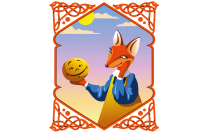Tridevyatoe tsarstvo
Many Russian fairytales begin with the line “В тридевятом царстве, в тридесятом государстве…” (“In Tridevyatoe kingdom, in Tridesyatoe country...”). This name definitely sounds like it has to do with numbers (tridevyatoe – tridsat' devyat’ – thirty-nine) but researchers still aren’t sure about the true meaning behind it.
Tridevyatoe tsarstvo refers to a magical reality a hero enters in order to complete his quest. There, he meets mythical creatures (such as Zmei Gorynich and Firebird), fights evil (personified by characters like Koschei), and in the end gets rewarded for it by winning over a princess or receiving magical artifacts (e.g. apples of youth). Sometimes Tridevyatoe tsarstvo is also used simply as a synonym for “somewhere far away” but the mythological meaning is much more fascinating. You can learn more about this kingdom in Alexander Pushkin’s fairytales.
Kitezh
According to the legend, Kitezh, sometimes referred to as “Russian Atlantis”, is an underwater town in lake Svetloyar near Nizhny Novgorod. It is said that when Batu Khan, a ruler of the Golden Horde who tried to conquer Russia in the 13th century, wanted to attack Kitezh, people living there didn’t try to defend themselves. Instead, they prayed for salvation, and it came – the city suddenly began to submerge under the water. Many stories claim that you can hear bells chime under the lake, meaning that the magical town of Kitezh is still there.
Lukomorye
“У лукоморья дуб зеленый, златая цепь на дубе том…” (“There is a green oak-tree by lukomorye, there is a golden chain on it…”) is another line pretty much every Russian knows by heart. That’s how Alexander Pushkin starts his famous Ruslan and Lyudmila poem. But what is lukomorye? You won’t find it on modern maps. At the same time, it wasn’t Pushkin who came up with it – this name has a far more ancient history.
The term dates back to the 11-12th centuries and back then it meant a bay or a bight, so you can actually find several lukomoryes on very old maps. In Slavic mythology, however, it’s a magical place where the arbor mundi, or the world tree that grows throughout the three levels of the universe (the underworld, the human world, and the heavenly upper world) is located.
Tmutarakan
You might’ve heard this peculiar word in sentences like “it’s in the middle of nowhere, in some Tmutarakan.” Although it was a real-life city in the Middle Ages, in modern Russian it is used as a term to describe some super distant location you have no idea how to reach. The real-life Tmutarakan, however, had more specific coordinates. It was located in Krasnodar Krai and ruins attributed to it still can be seen there.
Buyan
Byan is a town on an island often mentioned in Russian folklore. Like Tridevyatoe tsarstvo, it’s a mythological location filled with magical objects that help heroes fight evil. For example, the oak-tree where Koschei’s death is hidden as described in Pushkin’s The Tale of Tsar Saltan grows there. Buyan is also important for the mythological worldview of ancient Slavs: Alatyr, a sacred stone, “a mighty force that has no end”, and the axis mundi, is placed on Byan. All wishes of those who manage to find it come true.
Hope this list of places no one – except for fairytale characters – can ever visit made you feel better! For stories about far more accessible locations, see our recent articles, such as this one on medieval architecture, or this one – with locations for book lovers.




